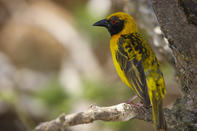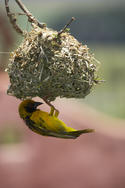
Name
Village weaver (Ploceus cucullatus)Appearance
The village weaver is possibly the most widely spread and common species of weaver in South Africa.
During the breeding season, the male village weaver has a yellow forehead and crown, with a black mask that extends only to the forehead. The nape, back of the neck and breast are yellow.
It is distinguished from the other masked weavers by the heavily blotched back. The eye is red and the bill is black.
The male has very similar colouring to the female, outside of the breeding season.
The female has a throat that is a dull yellow colour, a dirty white belly and a mottled back that is olive in colour. The female’s eyes are brown and the bill is black.
Diet
The village weaver is omnivorous and feeds on seeds, insects and nectar. This weaver is regarded as a pest in some farming areas as it causes damage to maize, rice and sorghum crops.Village Weaver Breeding

The village weaver is polygynous (the breeding practise of a male breeding with more than one female at the same time) and colonial.
The males will have up to 7 breeding females in his territory.
During breeding a male village weaver will do a mating dance, while hanging upside down, to try an attract the female to his nest.
When the female excepts the nest, she lines the nest with feathers, grass and leaves.
The female will lay between 2 and 4 eggs and incubation is carried out by the female and hatch after 12 to 14 days.
The female feeds the chicks and they fledge after 17 to 21 days. The village weaver is parasitized by the Diederik cuckoo.
Behaviour
A male will build a nest, normally taking around 1 day to build the nest, he will build up to 20 each season.
Any nest not accepted by the females will be destroyed to make way for a new nest. Nests are suspended from hanging branches, normally around 6 m and higher.
The village weaver is highly colonial, with up to 200 nests in a tree and some colonies can have as many as 100 nests in some seasons.
Due to the threat of brood parasites, each female village weaver has a unique egg pattern that is constant throughout her life. This allows her to discriminate against non-matching eggs.